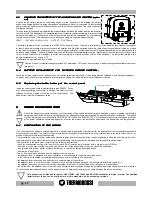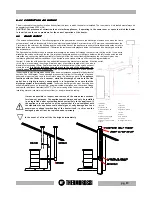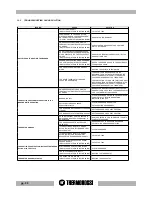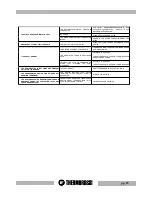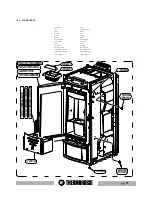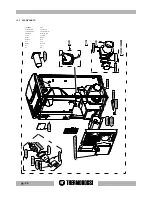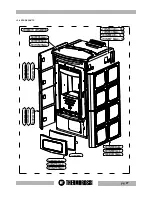
pg. 19
9.2
9.2
9.2
9.2
9.2
SMOKE OUTLET
SMOKE OUTLET
SMOKE OUTLET
SMOKE OUTLET
SMOKE OUTLET
•The smoke exhaust shown in the following figures is the best solution to ensure the discharge of smoke even when the fan is
not operational, such as for example if there is an electrical power failure. A minimum drop of 1.5 metres is required between the
T terminal on the outside of the building and the outlet at the back of the appliance, to ensure that residual combustion smoke is
discharged in the case described above (Otherwise the residues would stagnate inside the firebox and be discharged out to the
free atmosphere).
The figures below illustrate the best solution for discharging the smoke out through the roof or into the flue outlet. If you opt to
discharge the smoke out through the roof it is important to operate as shown in the figure below on the left. Insert a union tee with
inspection cap, connecting brackets suitable for the height of the flue outlet, flashing that crosses the roof and chimney cap
to protect against bad weather conditions. If you decide to use a classic masonry outlet see the diagram below on
the right. A union tee with inspection cap and suitable supporting brackets are required. If the flue outlet
is too big we recommend inserting a stainless steel or porcelain-coated steel tube with a
diameter not exceeding 150mm. Seal area where the inlet and outlet part of the smoke exhaust
meets the wall. It is strictly forbidden to apply mesh to the end of the outlet tube , as
it could cause the heater to malfunction If the smoke tube is installed in a fixed position
it is advisable to provide inspection openings for clean-out purposes especially in the horizontal
sections. See the diagram. These openings are essential to allow for the removal of ash and
unburned products which tend to accumulate along the discharge path. The appliance
functions with the firebox in a vacuum, while the discharge of smoke to the flue
outlet has a slight pressure, consequently it is imperative to ensure that the
discharge system is hermetically sealed. The smoke discharge tube must be made from
suitable materials such as for example: porcelain-coated steel tubes, and the various fittings
sealed with red silicone (resistant to 350°C). The outer casing of the tube must be made with
insulating material (mineral wool, ceramic fiber) or use pre-insulated tubing.
In the event of a fire call the fire brigade immediately.
9 . 1 . 1
9 . 1 . 1
9 . 1 . 1
9 . 1 . 1
9 . 1 . 1
COMB
COMB
COMB
COMB
COMBUSTION
USTION
USTION
USTION
USTION AIR INT
AIR INT
AIR INT
AIR INT
AIR INTAKE
AKE
AKE
AKE
AKE
The air required for combustion is taken directly from the room in which the heater is installed. The room where it is installed must always be
adequately ventilated (1300 m3/h) .
CAUTION: The presence of extraction fans or similar appliances, if operating in the same room or space in which the heater
is installed, could cause problems for the correct operation of the heater.
K E Y
Inspection
Slope 3-5%
Height more than 4m
Internal
External
Rain protection
Cover slab
Watertight steel sheet
It must be possible to inspect and remove all the smoke tube sections
for clean-out purposes. The appliance must always and only be installed
in a single flue outlet system dedicated exclusively to the appliance. If
the appliance is connected to a flue system that is non-compliant with
the standards the appliance could show signs of early damage due to an
anomalous continual overheating of the heater itself : in this case the
damaged parts will not be replaced under warranty.
LEGENDA
Ispezione
Pendenza 3-5%
Altezza superiore a 4m
Interno
Esterno
Protezione dalla pioggia
Lastra di copertura
Lamiera di acciaio a tenuta
stagna
Summary of Contents for ECOTHERM 5000
Page 16: ...pg 16 ...
Page 17: ...pg 17 ...














